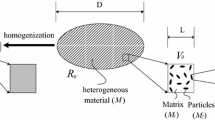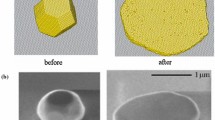Summary
A general method is proposed to account for the geometrical distribution of material inhomogeneity. It consists in a two-step micro-macro transition. The randomly inhomogeneous material is envisaged as made of cells, each one with a definite distribution of material inhomogeneity, i.e. with a definite “state”. Only a finite number of different states is considered for the cells. In other words, many identical cells exist, though at random places in the material. In the first step, the behavior of each set of identical cells, i.e., the constitutive relation that relates the average stress in that set of cells to the average strain-rate in the same set, is obtained by periodic homogenization. In the second step, a variational model is used to get the macroscopic behavior of the material, i.e. to appropriately average over the different sets of cells. The method is theoretically justified. It is then applied to a fibre-reinforced mortar. It is efficient in predicting the mechanically measured reinforcement. The influences of the fibres arrangement and the friction coefficient are investigated: an arrangement is found to reinforce more effectively than does another one.
Similar content being viewed by others
References
Hill, R.: The elastic behaviour of a crystalline aggregate. Proc. Phys. Soc. London Ser.A65, 349–354 (1952).
Hill, R.: The essential structure of constitutive laws for metal composites and polycrystals. J. Mech. Phys. Solids15, 79–95 (1967).
Zeller, R., Dederichs, P. H.: Elastic constants of polycrystals. Phys. Stat. Solid.55, 831–842 (1973).
Berveiller, M., Zaoui, A.: Modeling of the plastic behavior of inhomogeneous media. J. Eng. Mater. Technol.106, 295–298 (1984).
Iwakuma, T., Nemat-Nasser, S.: Finite elastic-plastic deformation of polycrystalline metals and composites. Proc. R. Soc. London Ser.A394, 87–115 (1984).
Lipinski, P., Berveiller, M.: Elastoplasticity of micro-inhomogeneous metals at large strains. Int. J. Plasticity5, 149–172 (1989).
Molinari, A., Canova, G. R., Ahzi, S.: A self-consistent approach of the large deformation polycrystal viscoplasticity. Acta Metall.35, 2983–2994 (1987).
Kröner, E.: Self-consistent scheme and graded disorder in polycrystals elasticity. J. Phys. F: Metal Phys.8, 2261–2267 (1978).
Gilormini, P.: A shortcoming of the classical non-linear extension of the self-consistent model. C. R. Acad. Sci. Paris320, Série IIb, 115–122 (1995).
Nemat-Nasser, S., Iwakuma, T., Hejazi, M.: On composites with periodic microstructures. Mech. Mater.1, 239 (1982).
Dvorak, G. J., Teply, J. L.: Periodic hexagonal array models for plasticity analysis of composite materials. In Plasticity today: modeling, methods and applications (Sawczuk, A., Bianchi, W., eds.), pp. 623–642. Amsterdam: Elsevier 1985.
Agah-Tehrani, A.: On finite deformation of composites with periodic microstructure. Mech. Mater.8, 255–268 (1990).
Sanchez-Palencia, E.: Non-homogeneous media and vibration theory. Berlin: Springer 1980.
Bensoussan, A., Lions, J. L., Papanicolaou, G.: Asymptotic analysis for periodic structures. Amsterdam. North-Holland 1978.
Suquet, P.: Plasticité et homogénéisation. Thèse de Doctorat d'Etat, Université Paris6, 1982.
Suquet, P.: Elements of homogenization for inelastic solid mechanics. In: Homogenization techniques for composite media (Sanchez-Palencia, E., Zaoui, A., eds.), pp. 193–278. Berlin Heidelberg New York: Springer 1987
Christensen, R. M., Lo, K. H.: Solution for effective shear properties in three phase sphere and cylinder models. J. Mech. Phys. Solids27, 315–330 (1979).
Bornert, M., Hervé, E., Stolz, C., Zaoui, A.: Self-consistent approaches and strain heterogeneities in two-phase elastoplastic materials. In: Micromechanics of random media (Ostoja-Starzewski, M., Jasiuk, I., eds.). Appl. Mech. Rev.47, N0 1, Part 2, pp. S66–S76 (1994).
Suquet, P.: Analyse limite et homogénéisation. C. R. Acad. Sci. Paris, Sér. II,296, 1355–1358 (1983).
Arminjon, M., Chambard, T., Turgeman, S.: Variational micro-macro transition, with application to reinforced mortars. Int. J. Solids Struct.31, 683–704 (1994).
Arminjon, M.: Limit distribution of the states and homogenization in random media. Acta Mech.88, 27–59 (1991).
Arminjon, M., Bottero, A., Guessab, B., Turgeman, S.: Comments on a variational model for random composites and the integration of microstructural data. In: Proc. IUTAM Symp. Microstructure-Property Interactions in Composite Materials (Pyrz, R., ed.), pp. 1–14. Dordrecht: Kluwer 1995.
Hill, R.: On macroscopic effects of heterogeneity in elastoplastic media at finite strain. Math. Proc. Camb. Phil. Soc.95, 481–494 (1984).
Ziegler, H.: An introduction to thermodynamics. Amsterdam: North Holland 1977.
Hill, R.: Extremal paths of plastic work and deformation. J. Mech. Phys. Solids34, 511–523 (1986).
Werner, E. A., Siegmund, T., Weinhandl, H., Fischer, F. D.: Properties of random polycrystalline two-phase materials. In: Micromechanics of random media (Ostoja-Starzewski, M., Jasiuk, I., eds.). Appl. Mech. Rev.47, No 1, Part 2, pp. S231–S240 (1994).
Arminjon, M., Imbault, D.: Physical meaning and experimental check of a variational principle for macro-to-micro transition. In: Proc. IUTAM Symp. Micro- and Macrostructural Aspects of Thermoplasticity (Bruhns, O. T., Stein, E., eds.), Dordrecht: Kluwer (to appear).
Christman, T., Needleman, A., Suresh, S.: An experimental and numerical study of deformation in metal-ceramic composites. Acta Metall. Mater.37, 3029–3050 (1989).
Böhm, H. J., Rammerstorfer, F. G., Weissenbeck, E.: Some simple models for micromechanical investigations of fiber arrangements in MMCs. Comput. Mater. Sci.1, 177–194 (1993).
Michel, J. C., Suquet, P.: On the strength of composite materials: variational bounds and numerical aspects. In: Topology design of structures (Bendsoe, M. P., Mota-Soares, C., eds.), pp. 355–374. Dordrecht: Kluwer 1993.
Chambard, T.: Contribution à l'homogénéisation en plasticité pour une répartition aléatoire des hétérogénéités. Thèse de Doctorat, Université Joseph Fourier. Grenoble, 1993.
Stassi d'Alia, F.: Flow and fracture of materials according to a new limiting condition of vielding. Meccanica, September, 178–195 (1967).
Turgeman, S.: Méthode numérique pour le dimensionnement des ouvrages en sols renforcés. Proc. Coll. Méthodes et Outils pour l'Ingénierie B.T.P., pp. 191–202. Université de Savoie, Chambéry, France, 1989.
Jaynes, E. T.: Information theory and statistical mechanics. Phys. Rev.106, 620–630 (1957).
Author information
Authors and Affiliations
Rights and permissions
About this article
Cite this article
Arminjon, M., Guessab, B. A model with two micro-scales for the effects of geometrical distribution of material inhomogeneity. Acta Mechanica 134, 61–79 (1999). https://doi.org/10.1007/BF01170304
Received:
Revised:
Issue Date:
DOI: https://doi.org/10.1007/BF01170304




